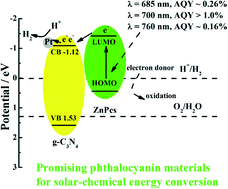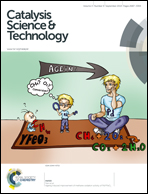Asymmetry and electronic directionality: a means of improving the red/near-IR-light-responsive photoactivity of phthalocyanine-sensitized carbon nitride†
Abstract
Extremely efficient photocatalytic H2 production with a turnover number (TON) of 25 002 for 20 h over graphitic carbon nitride (g-C3N4) sensitized by zinc phthalocyanines (ZnPcs) with asymmetric and electronic directional structures is successfully carried out under λ ≥ 500 nm light irradiation, and an impressive apparent quantum yield (AQY) higher than 1.0% is obtained under 700 nm monochromatic light irradiation. Based on the photoactivity, photofluorescence (PL), time-resolved fluorescence spectroscopy (TRFS), photocurrent, and electrochemical impedance spectroscopy (EIS) results, it is found that the asymmetry and electronic directionality of ZnPcs can significantly influence the photogenerated electron transfer between ZnPcs and g-C3N4 and further influence the photocatalytic H2 production activity of the phthalocyanine-sensitized g-C3N4 system. The present work exhibits the promising application of phthalocyanine materials in extending red/near-IR light utilization and gives some suggestions and routes for the design and synthesis of phthalocyanine derivatives for solar energy conversion applications.


 Please wait while we load your content...
Please wait while we load your content...